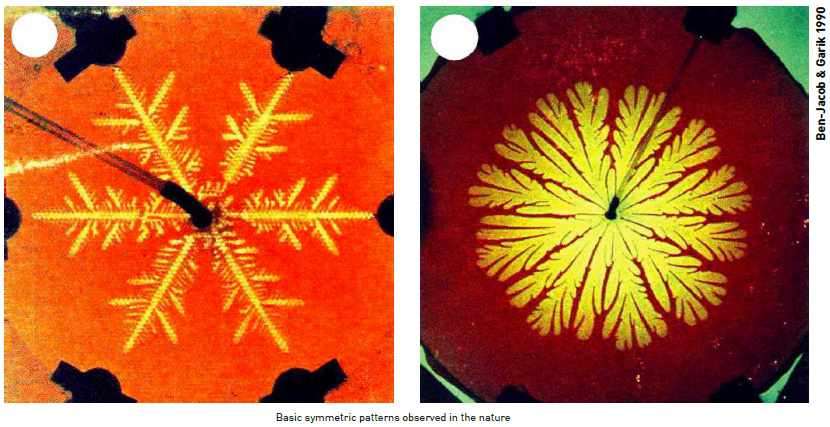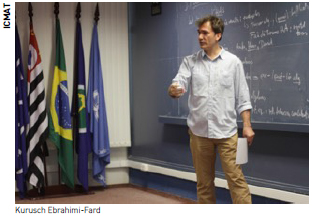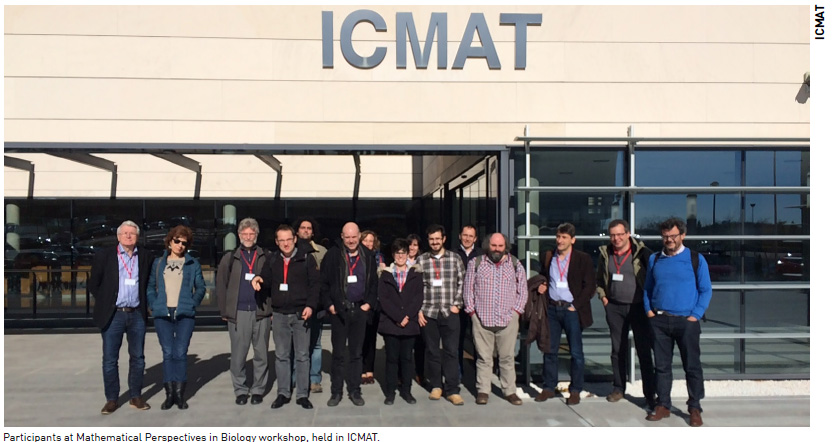 |
| Back |
| REPORT: International workshop in mathematical biology at the ICMAT |
|
THE MICROSCOPE IS MATHEMATICS A profound knowledge of biological mechanisms enables future irreparable threats to be anticipated and avoided, such as the consequences of climate change and the disappearance of species; it provides a faster alternative for the development of pharmaceutical drugs; it personalizes the fight against cancer, and helps in the effective management of fishing resources. To that end, mathematical biology provides a tool capable of modelling living systems and thereby to understand the processes sampled as well as testing hypotheses with simulations. It is also able to go further in the observation of reality when the information in a given sample is too little or too great. This symbiosis between the two sciences is in the ascent and promises to furnish excellent results.
Elvira del Pozo Campos. In a recent interview, the director of the prestigious Weizmann Institute of Science (Israel), Daniel Zajfmann, states that: “The next scientific revolution will come from a multidisciplinary group of scientists”. He is referring to the collaboration between computation, mathematics, physics and biomedicine as one of the most promising fields in the fight against cancer. This is one of the research lines in mathematical biology, a discipline that is on the rise and to which the workshop Mathematical Perspectives in Biology, held in February of this year at the Instituto de Ciencias Matemáticas (ICMAT), was dedicated. At this meeting, models were presented on which national and international research teams are working in fields such as the development of new drugs, the spread of epidemics, the effects of climate change and over-fishing in biodiversity. As one of the organizers of the conference and ICMAT researcher, Kurusch Ebrahimi-Fard, explains: “The aim was to determine the mathematical research lines related with biology and to promote dialogue between the different centers”.
Instead of magnifying all the details, a microscope reveals the most important information. Tomás Alarcón, an expert in the modelling of tumors at the Centre de Recerca Matemàtica Computational and Mathematical Biology Unit (CRM), says that the work of a mathematician in this field is “to sift through every detail of all the literature published in Biology and boil it down to the basics and the similarities”. The result is that this process “generates equations that capture the essential features of reality and leaves aside what is superfluous”, adds Antonio Gómez Corral, ICMAT member and a professor at the Complutense University of Madrid (UCM). Biology has currently moved from describing nature to attempting to understand how it functions. A model provides indicators, a framework of comparison and an overall vision. “Mathematical biology generates equations that capture the essential features of reality and leaves aside what is superfluous” However, there was not always such harmony between the two sciences: since their first collaboration in the late 18th century, biologists have criticized mathematical results as being unreliable, says Gómez Corral, because they regarded the models as a clumsy copy of complex living systems. Another organizer of the workshop and also a UCM researcher, Francisco Cao, says that it was only a few decades ago when more robust mathematical tools – mainly stochastic ones – began to be used in fields such as ecology and population analysis. He also states that “their use at a celular and molecular level is rather more recent”. Technological advances enable measurements to be made that were not possible before, which constitutes a data source that allows a greater acquisition of knowledge. As Cao explains: “This has acted as a spur for mathematics to create new tools to help in the understanding of the enormous amount of data being measured”. In his opinion, “since in the natural sciences every problem is singular, the mathematics employed is extremely varied”. Mathematics can also resolve the inverse problem: when there is not sufficient information. It is impossible to sample everything in the necessary detail and in all parts of the world, but mathematics completes the image. Bernt-Erik Sæther, biologist at the Norwegian University of Science and Technology (NTNU), points out that: “The algorithms extrapolate and generate values where there is no real measurement”.
Asocial fish 96% of Mediterranean fish stocks (individual fish whose size and species allow them to be fished) managed by the European Union are overfished, and seven out of ten of those in the Atlantic region fail to comply with the sustainability recommendations, according to the New Economics Foundation (NEF) and Oceana. Given this situation, the EU has set the target of meeting the quotas in all the fishing grounds by 2002, while Oceana is demanding “immediate emergency closures”. What is the reason for such urgency? As mathematician at the NTNU, Steinar Engen, explains: “It’s not easy to recover fish populations simply by stopping fishing”. In an article he published jointly with Sæther, Engen found that “intensive fishing affects the genetics of fish populations and leads to permanent consequences in these populations”. Certain individuals respond better to conditions of stress and these are the ones that survive. When pressure on the fishing ground is lifted “the consequences are not immediately evident”, because the organisms that remain may not be the best adapted to the density of large populations. “The algorithms extrapolate and generate values where there is no real measurement” The permanent loss of species, like the impact on their genetics as well as the changes and interactions between them, “may take a long time to become manifest, and by then the effects may well be irreversible”, says Sæther. It is here where mathematical models can make a contribution to this matter, since they enable us to foresee the evolution of a natural system, to detect problems before it’s to late and thus design preventative measures”, says another organizer of the event, Steven Gray, professor of computational engineering at the Old Dominion University (USA): “Everybody who eats is necessarily involved in these things”.
Elephants, mice and phytoplankton A further function of mathematical tools is that they “enable us to verify whether the perception of observers and the hypotheses they put forward are correct”, states Emilio Marañón, a researcher with the Universidad of Vigo Department of Ecology and Animal Biology. His team has shown that, contrary to what was believed before, the so-called mouse to elephant curve is not universal. This law establishes an inverse relation between the size of an individual and the speed at which it grows. Marañón explains that, to date, it was regarded as valid for all animal species, but it is now known that it is not valid for phytoplankton. “Small algae and large algae grow more or less a the same rate; it’s the medium-sized algae that grow more quickly”. This discovery may have remained as little more than a wildlife curiosity, were it not for the fact that these microscopic plants play an important role in the ecological balance of the Planet. They form the basis of the food chain in oceans, says Marañón, and produce half the oxigen released annually into the atmosphere. Knowledge of how they function can provide us with indicators for detecting changes in the environment, such as acidification of the seas, as well as helping us to design strategies for preserving biodiversity. “It’s not easy to recover fish populations simply by stopping fishing” In this case, it was the observations that indicated that the model that was valid for “large animals” could not be extrapolated to these marine microorganisms. However, in Marañón’s opinion, this is far from being a step backwards: “This deviation between the results of the algorithm and the measures provides a lot of information for the creation of new patterns as well as reinforcing those that are still useable”.
On Zika and other demons In a recent talk at the Real Academia de Ciencias Exactas, Físicas y Naturales (RAC), the virologist Esteban Domingo stated that: “A new viral infection appears every year; last year it was Ebola and this year it’s Zika”. This frenetic rate contrasts with the fact that it takes a decade to develop drugs to combat these diseases”, says Elena Akhmatskaya, a researcher at the (BCAM - Basque Center for Applied Mathematics). A “faster and cheaper” alternative would be to model the virus in question, the organism it attacks and the chemical substance to be tested as an antidote. “After that, by means of computational techniques, thousands of hypotheses could be simulated in a matter of hours”. “So why are we still carrying out tests on animals and on volunteers?” asks Akhmatskaya. “Because no models exist that are complete enough to represent such complex systems, such as the human body or viruses”, she replies, “and developing these models takes a lot of time. So far, it’s been possible to reduce very simple viruses in plants to algorithms, but those that attack human beings are too complex”. While the search for antidotes goes on, epidemics continue to proliferate, and mathematics, as Antonio Gómez Corral explains, can provide “stochastic models that include the randomness of the real world for predicting with much greater precision the possible duration of the outbreak – flu this year, for example – and estimate probabilistically the number of individuals who may be affected over time”. They may also enable foresee the medical protocols required in order to avoid a breakdown in health services. At any rate, problems in biology are so many and so complex, says Akhmatskaya, that not only synergy with mathematics is necessary, but also with statistics, chemistry, physics and computation in order to develop sophisticated algorithms. “All is number,” was Pythagoras’ (570-495) dictum, and as Akhmatskaya concludes: “The more complex a problem is to solve, the more difficult it is to obtain the algorithms. And every little helps.
Tumor, don’t resist! Tomás Alarcón, a researcher at the Computational and Mathematical Biology Unit of the Centre de Recerca Matemàtica (CRM), explains that one of the main causes of the lack of effectiveness in cancer treatment is that cancerous cells develop a resistance to drugs. One of the “most suprising” results of his research work with mathematical models for tumor growth is that, “when the tumor is attacked with a particular drug, it behaves like an overexploited shoal of fish; those cells that best adapt to the new conditions, i.e., that chemical substance, are selected indirectly”. If the same therapy is used over and over again, the tumor eventually becomes more resistant to it. The ultimate aim is to establish as habitual in clinical practice the use of algorithms that include information about the patient and enable a personalized treatment, says Víctor Pérez, director of the Laboratorio de Oncología Matemática (MOLAB). This would provide a way of reducing the use of therapies that are not very effective. Images of the cysts provide a great deal of data, and the challenge is to develop the appropriate models to predict the particular behavior the cancerous cells may have, based on real information, says Pérez, who concludes that: “At the moment, none exist that are being applied to assist in the decision-making process for patients suffering from cancer, but the outlook is promising”.
|


 This scientific area, in which natural processes are studied by using mathematics as a tool, is currently enjoying a rapid expansion. As Ebrahimi-Fard says, “Biology can stimulate the development of new mathematics, just as physics did in the last century. Mathematics is the new microscope in biology”. Last year he was also in charge of a BBVA Foundation project on mathematical methods for ecology and industrial management.
This scientific area, in which natural processes are studied by using mathematics as a tool, is currently enjoying a rapid expansion. As Ebrahimi-Fard says, “Biology can stimulate the development of new mathematics, just as physics did in the last century. Mathematics is the new microscope in biology”. Last year he was also in charge of a BBVA Foundation project on mathematical methods for ecology and industrial management.